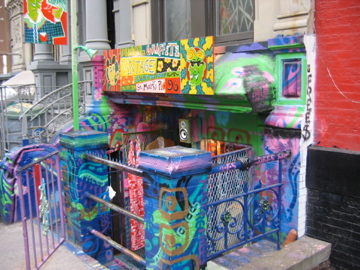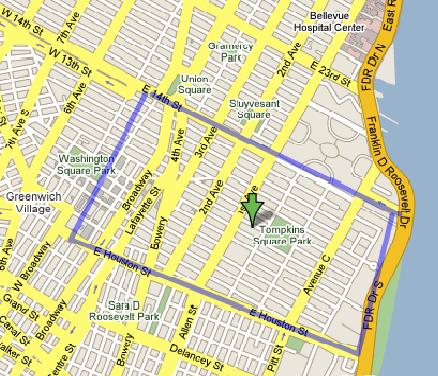East Village
From Decoding New York
| Introduction |
| The East Village |
| * Evolution |
| * Here v. There |
| * Economy |
| * What's Real |
| Bay Ridge |
| * Evolution |
| * Here v. There |
| * Economy |
| * What's Real |
| Comparison |
| * Photo Gallery |
| * Sources
|
The East Village occupies the area between 14th Street and Houston Street in Manhattan, stretching from the East River to either Broadway or Fifth Avenue, depending on who you ask. It provided work and crowded tenement housing to a succession of working-class ethnic groups, part of the low-rent Lower East Side through which so many immigrant communities passed on their way to the bigger and better. The East Village as a distinct neighborhood, on the other hand, has been around for maybe fifty years, dating back to the eastward migration of artists from Greenwich Village. "It used to be a place of low income families, low rent, and silence. Now, the artists are moving in, pressing for more space and using their money and fame to buy places out." (Samuel DeVargas Interviews) The rents have started rising, even as a healthy ethnic community – mostly Dominican and Puerto Rican – survives, and the neighborhood is now one of contrasts: on the one hand, residents who have grown up knowing it as the arty, edgy East Village fight to preserve it in the face of the gentrification that seems to inevitably follow such ideas. On the other hand, the working-class ethnic community goes on as others have before, with an altogether more utilitarian, less neighborhood-brand-conscious approach.
The old and new East Village intersect at the iconic intersection of Astor Place and the Bowery, , St. Mark's, and Fourth Avenue. A new glass-faced apartment building towers over the other buildings on what was just a parking lot two years ago. The Alamo (1967), by Tony Rosenthal, sits on the traffic island at the center of the intersection. This sculpture, an eight-foot steel cube standing on one corner, has become a popular gathering place for East Villagers and tourists alike (In 2003, it was briefly turned into a giant Rubik's cube). A block away stands Cooper Union, a free college founded by Peter Cooper, a working-class immigrant's son who grew up to live out the American Dream, becoming a driving force behind such revolutionary projects as the Transcontinental Railroad, the Transatlantic Cable, and Jello.
In the scant centuries the area has seen, it has been home to some of the most famous – and infamous - artists, political movements, riots, and leaders that this city and the world have seen, a place of experiments in everything from literature to drugs. Many traces of the earlier ethnic populations are disappearing, though not without a fight. This neighborhood is, like so many others, in flux, and its future is still too close to call.

